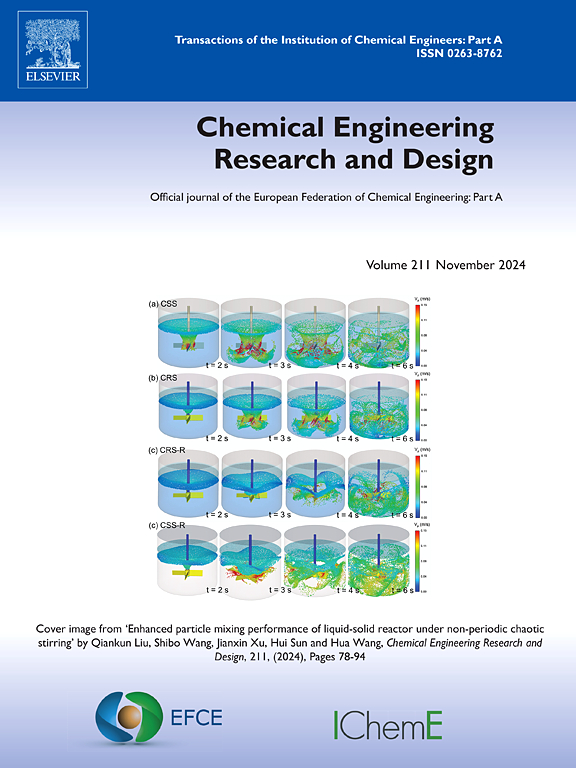颗粒横流鼓泡流化床液位控制的分散模型
IF 3.7
3区 工程技术
Q2 ENGINEERING, CHEMICAL
引用次数: 0
摘要
具有大量连续的颗粒水平流动(横流)的流化床可以导致倾斜的床面,使热交换器浸入被不同数量的颗粒覆盖的流化床中。这有利于颗粒绕过热交换器,从而降低其效率。加压区可以用来控制沿颗粒水平路径的床层水平,实现颗粒在换热器中的更均匀分布。设计该液位控制系统需要一个考虑增压区影响的颗粒流物理模型,本文为此建立了一个新的颗粒分散模型。通过动态仿真和实验对该模型进行了标定和验证。该模型能够在几毫米范围内准确预测受加压区影响的床层水平的动态行为。该模型可用于流化床液位控制系统的设计和分析。为了使新的颗粒分散模型具有普遍适用性,还需要进一步研究颗粒分散的其他影响因素,特别是换热器的配置。本文章由计算机程序翻译,如有差异,请以英文原文为准。
Dispersion model for level control of bubbling fluidized beds with particle cross-flow
A fluidized bed with a large, continuous horizontal flow of particles (cross-flow) can lead to a sloped bed level, leaving a heat exchanger immersed in the fluidized bed covered by different amounts of particles. This facilitates particles bypassing the heat exchanger, thereby reducing its efficiency. Pressurized zones can be utilized to control the bed level along the particles' horizontal path, achieving a more even distribution of particles across the heat exchanger. Designing this level control system requires a physical model of the particle flow that accounts for the impact of pressurized zones, for which a new particle dispersion model was developed in this study. Dynamic simulations and experiments on a test rig were used to calibrate and validate the new particle dispersion model. The model was able to correctly predict the dynamic behavior of bed levels influenced by pressurized zones within a few millimeters. This model can be used to design and analyze a fluidized bed level control system. Further research on additional influencing factors of particle dispersion, in particular the heat exchanger's configuration, is still required to achieve general applicability of the new particle dispersion model.
求助全文
通过发布文献求助,成功后即可免费获取论文全文。
去求助
来源期刊

Chemical Engineering Research & Design
工程技术-工程:化工
CiteScore
6.10
自引率
7.70%
发文量
623
审稿时长
42 days
期刊介绍:
ChERD aims to be the principal international journal for publication of high quality, original papers in chemical engineering.
Papers showing how research results can be used in chemical engineering design, and accounts of experimental or theoretical research work bringing new perspectives to established principles, highlighting unsolved problems or indicating directions for future research, are particularly welcome. Contributions that deal with new developments in plant or processes and that can be given quantitative expression are encouraged. The journal is especially interested in papers that extend the boundaries of traditional chemical engineering.
 求助内容:
求助内容: 应助结果提醒方式:
应助结果提醒方式:


